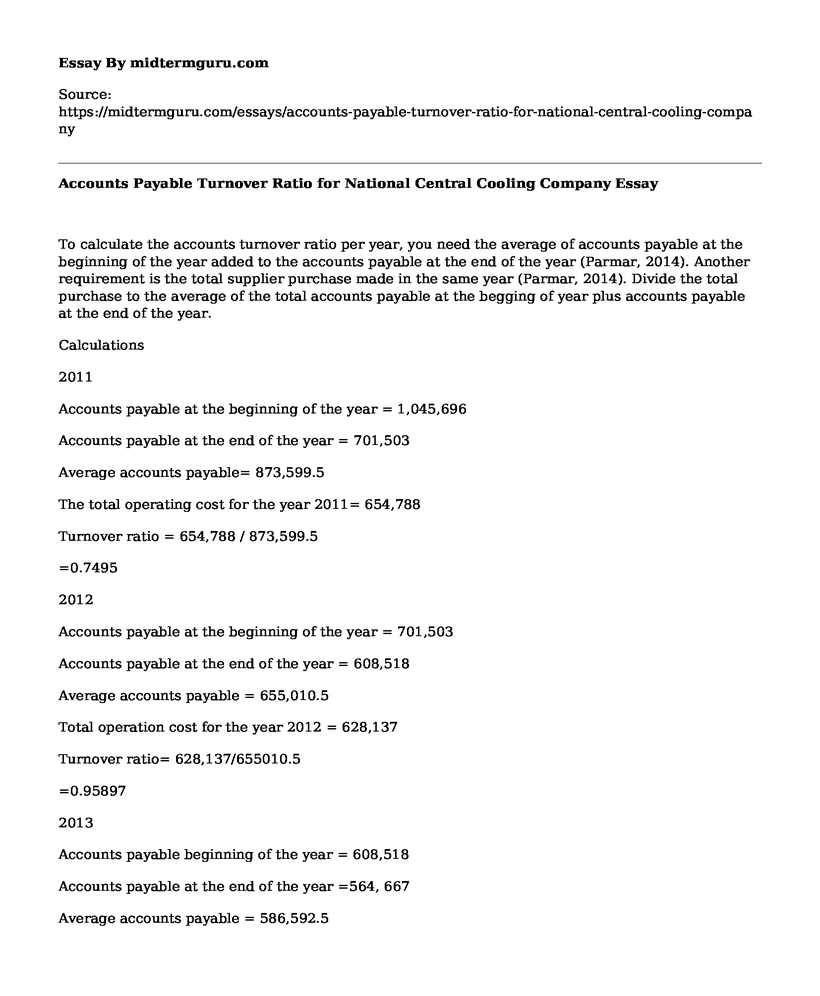To calculate the accounts turnover ratio per year, you need the average of accounts payable at the beginning of the year added to the accounts payable at the end of the year (Parmar, 2014). Another requirement is the total supplier purchase made in the same year (Parmar, 2014). Divide the total purchase to the average of the total accounts payable at the begging of year plus accounts payable at the end of the year.
Calculations
2011
Accounts payable at the beginning of the year = 1,045,696
Accounts payable at the end of the year = 701,503
Average accounts payable= 873,599.5
The total operating cost for the year 2011= 654,788
Turnover ratio = 654,788 / 873,599.5
=0.7495
2012
Accounts payable at the beginning of the year = 701,503
Accounts payable at the end of the year = 608,518
Average accounts payable = 655,010.5
Total operation cost for the year 2012 = 628,137
Turnover ratio= 628,137/655010.5
=0.95897
2013
Accounts payable beginning of the year = 608,518
Accounts payable at the end of the year =564, 667
Average accounts payable = 586,592.5
Operations cost for the year 2013= 592,127
Turnover ratio= 592,127 / 586,592.5= 1.009
2014
Accounts payable beginning of the year = 564,667
Accounts payable at the end of the year = 521,381
Average accounts payable = 543,024
Total operations cost for the year 2014 = 597, 020
Turnover ratio 2014 = 597,020 / 543,024
= 1. 099
2015
Accounts payable beginning of the year = 521,381
Accounts payable at the end of the year = 568,001
Average accounts payable = 544,691
Total operation cost for the year 2015 = 611,235
Turnover ratio = 611,235 / 544,691
= 1.122
Profit margin ratio
To get the profit margin ratio, divide the net income by the net sales. Net income is the total revenues subtract the total expenses. Net sales is the remainder after subtracting refunds from the gross sales.
2011
Net income = total revenue operational cost
1,114,571 654,788 = 459,783
Net sales = 466,135 (The balance at the end of the year for the capital work in progress).
Profit margin ratio = Net income / Net sales
= 459, 783 / 466, 135
= 0.9864
2012
Net income = Total revenue Operational cost
1,128,738 -628,137 = 500,601
Net sales = 110,829 (The balance at the end of the year for the capital work in progress).
Profit margin ratio = Net income / Net sales
= 500,601 / 110, 829
= 4.51688
2013
Net income = Total revenue Operational cost
1,100,188 592,127 = 508061
Net sales = 450,582 (The balance at the end of the year for the capital work in progress).
Profit margin ratio = Net income / Net sales
= 508,061 / 450,582
=1.12756
2014
Net income = Total revenue Operational cost
=1,130,612 597,020 =533592
Net sales = 157,117 (The balance at the end of the year for the capital work in progress).
Profit margin ratio = Net income / Net sales
= 533592 / 157,117
= 3.396
2015
Net income = Total revenue Operational cost
= 1,171,850 611,235 = 560615
Net sales = 304,723 (The balance at the end of the year for the capital work in progress).
Profit margin ratio = Net income / Net sales
= 560,615 / 304,723
= 1.83975
Column charts
Account payable turnover ratio and profit margin ratio
Analysis
The Accountable payable turnover ratio is a business tool that is used to evaluate the speed with which supplies are paid (Parmar, 2014). By use of this tool, one can determine the financial conditions of the company or business organization. From the data above, the turnover ratio increased from one year to the other indicating a good financial condition of the company.
On the profit margin ratio analysis, this ratio is used to measure the amount of income collected after every sale (Parmar, 2014). This ratio measures the profitability of the sales after deducting the expenses of the company (Parmar, 2014). It also measures the effectiveness of converting sales into net income (Parmar, 2014). From the chart above, the profit margin ratio has declined in some years like 2011, 2013, and 2015 compared to 2012 and 2014. A decline in profit margin ratio indicates that the company is making a small net income while a higher profit margin income indicates that more net income is being generated from the sales.
References
Parmar, V. (2014). Analysis Of Financial Statements: Understanding of Financial analysis,
Open Interest analysis, Ratio analysis and Equity analysis. Saarbrucken: LAP
LAMBERT Academic Publishing.
Cite this page
Accounts Payable Turnover Ratio for National Central Cooling Company. (2021, May 24). Retrieved from https://midtermguru.com/essays/accounts-payable-turnover-ratio-for-national-central-cooling-company
If you are the original author of this essay and no longer wish to have it published on the midtermguru.com website, please click below to request its removal:
- Sony Corporation in Australia - Paper Sample
- Evaluation Essay on Blockbuster Company
- Influencing Factors of Life Insurance Premium Income at Home and Abroad
- How the USA Does Business with Other Countries - Research Paper
- Paper Example on AAA HotelCo Representatives
- Evaluation Essay on Under Armour
- Creating a Recruitment Plan for R.J. Reynolds Tobacco Company - Research Paper







